Question of the Month
May 2010
Why is bat photography so difficult?
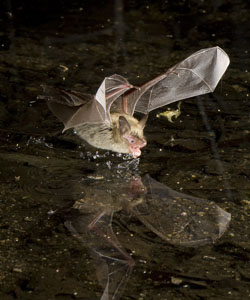
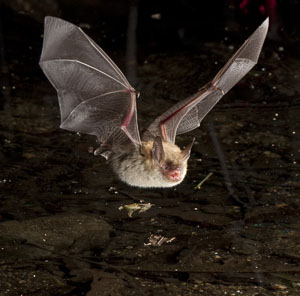
Check out our 2009-2010 Bat Portfolio
Because their small, fly fast, are dark-colored, and are active only at night! That's wy!
OK, that is the short answer, but it sums up the problems, or most of them. We just returned from Arizona where, in conjunction with our high speed hummingbird photo tour and workshop we offered our first bat shoot, restricted to just four photographers. It was only modestly successful, as two of the four days we were scheduled to shoot bats were too cold and windy for bat photography, and one of the two sites we had planned to use was flooded by decade record-breaking rain and snowfalls, making the site unusable.
To photograph bats one must use some type of camera-tripping device. The best I know of, and incredibly affordable, is the PhotoTrap. The inventor, my friend Bill Forbes, also had the property where we photographed the bats for this year's shoot, where at least four species visited his pond.
In using a camera-tripping device (I'll just refer to the PhotoTrap from this point on, as PT), there are two ways to attempt to catch bats. One can hard-wire a camera to the PT so that every time a bat breaks the PT's beams the camera first. In this way one can truly do unmanned photography as the camera will continue firing whenever a bat flies by, and will do so throughout the night or until the camera's batteries run out. Unfortunately, while that would seem to be the ideal method it comes at a cost, and that is the camera's inherent LAG TIME. Lag Time is the time it takes for the camera to actually fire after it receives a 'fire' signal from the PT. This Lag Time varies with the camera and can be as fast as 1/180th sec or as slow as about 1/20th of a second. At a slow lag time, like 1/20th, a bat flying 20 mph will travel about 1.5 feet during that time, so one would have to focus 1.5 feet beyond the beam's breaking point to achieve a sharp focus.
Bat's fly erratically and at different speeds, depending upon the species and upon what a bat is doing. A bat that hits the water for a drink will be moving a bit slower than a bat swooping down to the water or just traveling over it, so the focus point would vary. So ... where does one focus? It's a real 'shot in the dark.'
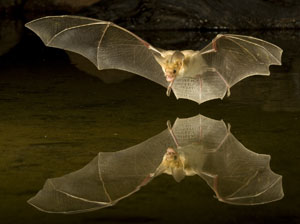 The other method is to have the PT wired to the flash and the camera set on Bulb so that the shutter is open when the flash fires, which will be virtually instantaneous with the breaking of the beam. The problem here is one must be manning the camera to insure the camera is on Bulb, or be prepared to waste a lot of frames by firing the camera automatically, either via a Pocket Wizard II or with an intervalometer or even a remote cord set for continuous firing.
The other method is to have the PT wired to the flash and the camera set on Bulb so that the shutter is open when the flash fires, which will be virtually instantaneous with the breaking of the beam. The problem here is one must be manning the camera to insure the camera is on Bulb, or be prepared to waste a lot of frames by firing the camera automatically, either via a Pocket Wizard II or with an intervalometer or even a remote cord set for continuous firing.
Controlling the path of a flying bat is difficult as well, and if one frames loosely so that there is a better chance that the bat will appear in the frame then the bat is likely to be small in that frame. Frame tightly for a bigger image and one runs a big risk of cutting off a wing, or much of a bat if it is flying off-center from your frame. One might think shooting a side-view would eliminate that issue and it does, but it presents another problem, and that's depth of field. With a 300mm focused at 10' and at f16 the depth of field will only be about 3.5 inches, so a shooting width of three feet or so - the average width for a bat-frequented watering area - leaves a lot of area for a bat to fly out of focus.
To catch a bat in flight one obviously has to use flash, since bats almost always fly at night or in the twilight hours. TTL flash probably won't work since a bat's shape may change and the area of the image will change, thus influencing the flash output. Manual flash works, but the flashes must be set to a low power ratio so that you'll have a fast flash duration, needed to freeze the bat's fast movement. Most flashes are weak at low power ratios, so a flash must be placed close to the target area.
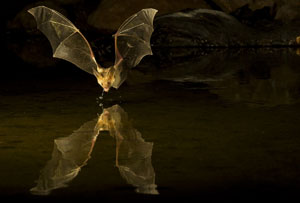 More than one flash should be used to achieve interesting or effective lighting, which brings up another problem, and that's synchronizing the flashes to fire at the same time. I was quite surprised to find that my wireless Canon flashes were not firing at the exact same speed, creating a ghost-blur as some flashes fired longer than I expected.
More than one flash should be used to achieve interesting or effective lighting, which brings up another problem, and that's synchronizing the flashes to fire at the same time. I was quite surprised to find that my wireless Canon flashes were not firing at the exact same speed, creating a ghost-blur as some flashes fired longer than I expected.
Using a slave unit to fire flashes should, in theory, create synchrony with flashes of the same type and set at the same power ratio, but there is a risk that the flashes may fire at slightly different times, which will cause blurring or ghosting as well. In theory, this shouldn't happen but I've seen it do so, which complicates the issue further!
Regardless of how a system is rigged to the PT the camera will be 'on' for a long time, either 'waiting' for the PT to trip the camera (if wired directly) or actually open if held on Bulb or continuously fired. Over the course of a few hours a battery may drain out, and to our surprise the Canon 1D Mark IV no longer comes supplied with an AC connection to power the camera via a household current! My friend had a Mark IV sent to our lodge in Arizona, planning on using the camera with an AC connection, and one wasn't included! Fortunately, the previous model, the Mark III, uses the same battery and that camera came with an AC adapter, but that didn't help him on this shoot! Canon needs a reprimand for that one!
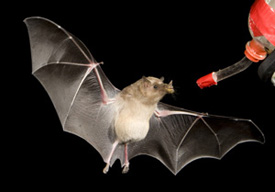 Nonetheless, I have solved these problems, although this year's shoot certainly wasn't as successful as I'd have liked it to be. Hopefully, I'll have a chance to work on some of our Pennsylvania bats this summer, and next year we're expecting that the whacky, unseasonable weather of 2010 won't be repeated in Arizona. To increase our odds, we're pushing back our two bat shoots by two weeks, giving the desert a real chance to heat up and for the Lesser long-nosed bats to return to the Canyon and to our hummingbird feeders.
Nonetheless, I have solved these problems, although this year's shoot certainly wasn't as successful as I'd have liked it to be. Hopefully, I'll have a chance to work on some of our Pennsylvania bats this summer, and next year we're expecting that the whacky, unseasonable weather of 2010 won't be repeated in Arizona. To increase our odds, we're pushing back our two bat shoots by two weeks, giving the desert a real chance to heat up and for the Lesser long-nosed bats to return to the Canyon and to our hummingbird feeders.
If you're interested in next year's bat shoot, contact our office ASAP to be on our first-contact list!
Questions of the Month
What do I think of the Canon 1D Mark IV?
How do I deal with shaving weight for carrying my gear?
Why do I advocate manual exposure so avidly?
Where can I find Depth of Field reference charts?
What is the Kiboko backpack? Is it the New Best Pack?
Is there a correct position for the upright on a Wimberley actionhead?
How, Who, and Why? The story behind our new web site.
Archived Questions of the Month
Most of my original Questions of the Month for the last several
years are available through this link. The 'look' is from my
original web site, although if I ever have enough time I might
redo these pages to match the new web site But that's not
a high priority.


